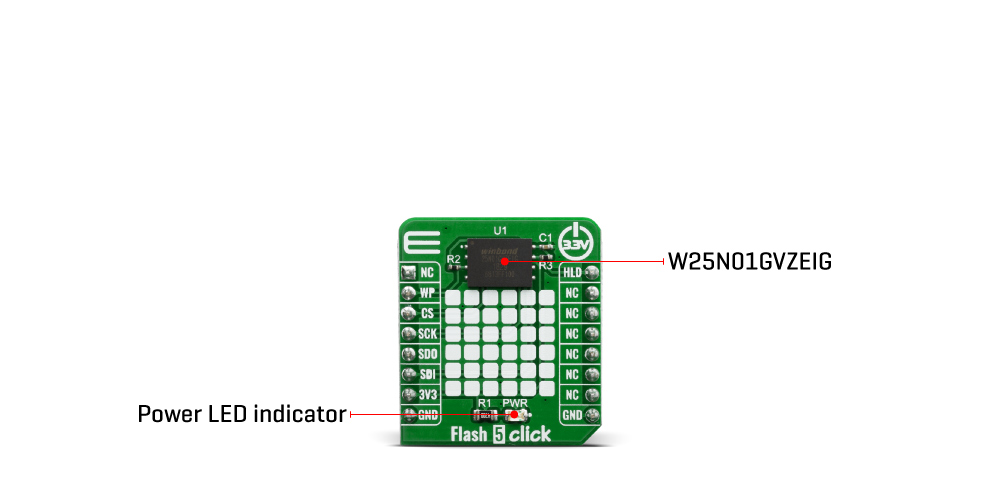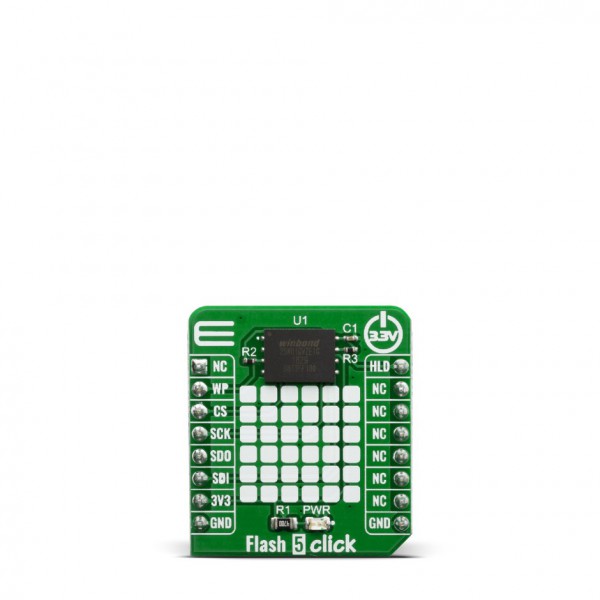- Order number: MIKROE-3780
- Manufacturer product ID: 3780
Flash 5 Click is a perfect solution for the mass storage option in various embedded applications. It features the W25N01GVZEIG/IT (1G-bit) Serial SLC NAND Flash Memory from Winbond which provides a storage solution for systems with limited space, pins and power. The W25N SpiFlash family incorporates the popular SPI interface and the traditional large NAND non-volatile memory space. They are ideal for code shadowing to RAM, executing code directly from Dual/Quad SPI (XIP) and storing voice, text and data.
The Flash 5 click is supported by a mikroSDK compliant library, which includes functions that simplify software development. This Click board™ comes as a fully tested product, ready to be used on a system equipped with the mikroBUS™ socket.
HOW DOES IT WORK?
The Flash 5 click is based on the W25N01GVZEIG/IT (1G-bit) Serial SLC NAND Flash Memory from Winbond. The device operates on a single 3.3V power supply with current consumption as low as 25mA active and 10µA for standby. All W25N SpiFlash family devices are offered in space-saving packages which were impossible to use in the past for the typical NAND flash memory.

The W25N01GVZEIG/IT 1G-bit memory array is organized into 65,536 programmable pages of 2,048-bytes each. The entire page can be programmed at one time using the data from the 2,048-Byte internal buffer. Pages can be erased in groups of 64 (128KB block erase). The W25N01GVZEIG/IT has 1,024 erasable blocks.
The Flash 5 click uses the standard Serial Peripheral Interface (SPI), supporting SPI clock frequencies of up to 104MHz. Besides that, the W25N01GVZEIG/IT provides a new Continuous Read Mode that allows for efficient access to the entire memory array with a single Read command. This feature is ideal for code shadowing applications. Also, it offers the highest performance thanks to the Serial NAND Flash with 104MHz Standard/Dual/Quad SPI clocks and a 50MB/S continuous data transfer rate. Given the fact it has a efficient “Continuous Read Mode”, it allows direct read access to the entire array. However, the performance also depends on the main MCU used with this Click board™.
A Hold pin, Write Protect pin and programmable write protection, provide further control flexibility. Additionally, the device supports JEDEC standard manufacturer and device ID, one 2,048-Byte Unique ID page, one 2,048-Byte parameter page and ten 2,048-Byte OTP pages. To provide better NAND flash memory manageability, user configurable internal ECC, bad block management are also available in W25N01GVZEIG/IT.
The W25N01GVZEIG/IT is accessed through an SPI compatible bus consisting of four signals: Serial Clock (CLK), Chip Select (/CS), Serial Data Input (DI) and Serial Data Output (DO). Standard SPI instructions use the DI input pin to serially write instructions, addresses or data to the device on the rising edge of CLK. The DO output pin is used to read data or status from the device on the falling edge of CLK.
For the detailed explanation, please consult the included datasheet. However, MikroElektronika provides a library which contains functions that simplify and speed up working with this device. The provided application example demonstrates the functionality of the library functions. It can be used as a reference for a custom project development.
This Click Board™ is designed to be operated only with 3.3V logic level. A proper logic voltage level conversion should be performed before the Click board™ is used with MCUs with logic levels of 5V.
SPECIFICATIONS
| Type | FLASH |
| Applications | A storage solution for systems with limited space, pins and power, code shadowing to RAM, executing code directly from Dual/Quad SPI (XIP) and storing voice, text and data. |
| On-board modules | W25N01GVZEIG/IT (1G-bit) Serial SLC NAND Flash Memory from Winbond |
| Key Features | W25N01GV: 1G-bit / 128M-byte, Compatible SPI serial flash commands, On chip 1-Bit ECC for memory array, -40°C to +85°C operating range |
| Interface | QSPI,SPI |
| Compatibility | mikroBUS |
| Click board size | S (28.6 x 25.4 mm) |
| Input Voltage | 3.3V |
PINOUT DIAGRAM
This table shows how the pinout on the Flash 5 click corresponds to the pinout on the mikroBUS™ socket (the latter shown in the two middle columns).
ONBOARD SETTINGS AND INDICATORS
| Label | Name | Default | Description |
|---|---|---|---|
| LD1 | PWR | - | Power LED Indicator |
SOFTWARE SUPPORT
We provide a library for the Flash 5 Click on our LibStock page, as well as a demo application (example), developed using MikroElektronika compilers. The demo can run on all the main MikroElektronika development boards.
Library Description
The library initializes and defines the SPI bus and drivers that offer a choice for writing data in memory and reads data from memory. The library includes function for controling configuration of the device, software reset and erasing memory.
Key functions:
void flash5_send_cmd ( uint8_t cmd_data )- Sends one Byte of datavoid flash5_page_read_memory ( uint16_t column_addr, uint8_t *data_buf, uint16_t buf_size )- Reads data from memory to buffervoid flash5_page_load_memory ( uint16_t column_addr, uint8_t *data_buf, uint16_t buf_size )- Writes data to memory from bufferuint8_t flash5_read_status_data ( uint8_t status_cmd, uint8_t status_addr )- Reads status of selected status registarvoid flash5_write_status_data ( uint8_t status_cmd, uint8_t status_addr, uint8_t status_data )- Writes status to selected status registarvoid flash5_erase_chip ( void )- Erases whole device memoryvoid flash5_software_reset ( void )- Resets device
Examples description
The application is composed of three sections :
- System Initialization - Initializes SPI module
- Application Initialization - Initializes driver, resets device, erasing one page of memory, tests communication and configures device
- Application Task - Writes "MikroE" to device memory and then reads it and sends it to log
void applicationTask( )
{
uint8_t n_counter;
flash5_send_cmd( FLASH5_CMD_WRITE_ENABLE );
flash5_page_load_memory( 0x000A, &write_buf[ 0 ], 6 );
flash5_page_read_memory( 0x000A, &read_buf[ 0 ], 6 );
for( n_counter = 0; n_counter < 6; n_counter++ )
{
mikrobus_logWrite( &read_buf[ n_counter ], _LOG_BYTE );
Delay_ms( 100 );
}
mikrobus_logWrite( "", _LOG_LINE );
mikrobus_logWrite( "-------------------", _LOG_LINE );
Delay_ms( 5000 );
}
The full application code, and ready to use projects can be found on our LibStock page.
Other mikroE Libraries used in the example:
- SPI
- Conversions
- UART
Additional notes and informations
Depending on the development board you are using, you may need USB UART click, USB UART 2 click or RS232 click to connect to your PC, for development systems with no UART to USB interface available on the board. The terminal available in all MikroElektronika compilers, or any other terminal application of your choice, can be used to read the message.
MIKROSDK
This Click board™ is supported with mikroSDK - MikroElektronika Software Development Kit. To ensure proper operation of mikroSDK compliant Click board™ demo applications, mikroSDK should be downloaded from the LibStock and installed for the compiler you are using.













